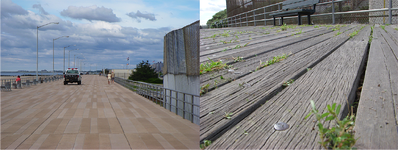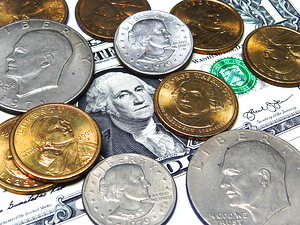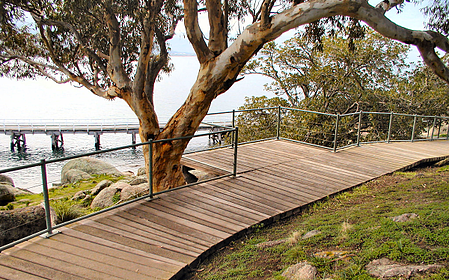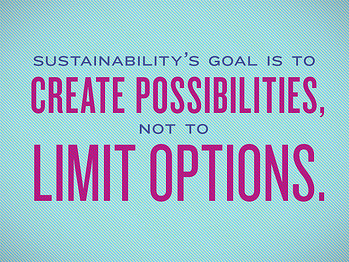The timber vs. concrete boardwalk debate has picked up over the last couple of years with large, public beach boardwalks like Long Beach and Rockaways, NY drawing a lot of attention. For a time, wooden boardwalks were most widely used, becoming beloved and iconic in places like Coney Island. After Hurricane Sandy, the term “concrete boardwalk” started becoming more popular as owners and designers discussed boardwalk reconstruction efforts in city council meetings and local news channels. Some joined Mayor Bloomberg by citing concrete’s durability and lack of required maintenance, while wood boardwalk advocates expressed their concerns that the famous wood structures would become “concrete beach sidewalks” that would chip and crack like they saw in streets and parking lots. Why would a “concrete boardwalk” be any different?

While Hurricane Sandy’s aftermath had a big impact on fueling this debate, the question has been around since the emergence of concrete boardwalks over the last several years. Architects and engineers often find themselves asking — do I choose timber or concrete for my boardwalk project? Not only is it up for public debate, navigating the pros and cons of boardwalk materials can be a design challenge as well.
At PermaTrak, though we certainly have a preference for precast concrete, we want to share with you some honest answers in the timber vs. concrete boardwalk discussion. Keep in mind that the answers for timber boardwalks may vary between manufacturers, wood types and other design specifications.
Boardwalk Design: Timber vs. Concrete Questions
How much does it cost?
Timber

The cost of a timber boardwalk greatly depends on the type of wood selected — and you get what you pay for! Southern Yellow Pine, for example, is a cheaper variety of timber. It suffers in areas of strength and durability. Hardwoods like Ipe are ideal for boardwalk construction as they are a superior building materials compared to softer woods. The up-front cost, however, is greater, and hardwoods are still susceptible to the maintenance and repair concerns that all timber faces. Ipe also faces quite a bit of pushback from environmental groups like Rainforest Relief, as its sources in the Amazon rain forest are heavily scrutinized.
PermaTrak Precast Concrete
While most boardwalk materials are priced by linear foot, PermaTrak, due to design variables for individual projects, prices precast concrete by the square foot. Cost estimates per square foot are highly dependent on the foundation type. Our precast concrete boardwalks range in price estimates per square foot from $40 up to around $110. You can read more about our concrete boardwalk construction costs here.
How long does it last?
Timber
While many timber boardwalk companies will claim their materials last 15-20 years, you should figure in some heavy maintenance over the years for it to continue as usable by the public. Timber, in order to hold up that long in a commercial setting, is pressure-treated with chemicals. This is a process that must be replicated over the years with stains and sealants as these treatments wear off and fade. We’ve now been in the public boardwalk business for 4 years. Over that time, we’ve heard from plenty of timber boardwalk owners that most of these structures will last 3-5 years without any maintenance and up to 12-15 years with heavy maintenance.
PermaTrak Precast Concrete
Per the Army Corps of Engineers- reinforced, precast concrete has a design life of 50 to 75 years. Because the precast concrete material does not contend with issues like bending, warping, splintering or rotting, many concrete boardwalk owners save tens of thousands of dollars by avoiding repair and/or replacement costs during that design life.
What kind of maintenance is required?
Timber
We’ve already mentioned that timber must be chemically treated to extend its lifespan and maintain its usability. Without diligent attention to these treatments, as well as other maintenance items like replacing screws and nails, timber boardwalks quickly become vulnerable to rot, warping and other breakdowns that call for replacement wood planks. The most effective way to get a sense for timber boardwalk maintenance is to go see one! How does it look after 3, 5 or 10 years?
PermaTrak Precast Concrete

None. Really! The most maintenance a precast concrete boardwalk needs is the occasional power-washing in the event of algae growth or dirt buildup and debris. How often does your city power-wash its sidewalks? Assuming there is a sidewalk cleaning program, concrete boardwalks could be placed in that same category. As an example, without any required maintenance, the concrete boardwalk system shown on the right has seen heavy commercial use for 18 years.
Related: click this article for more information on boardwalk maintenance, including life cycle cost comparisons between timber and concrete boardwalks.
How does it impact the environment?
Timber
 When selecting timber for boardwalk construction, always look to make sure that your selection is coming from a sustainable source. Many companies will highlight their sustainable practices. Look for seals by the Sustainable Forestry Initiative and other programs to be sure that the timber being cut is being replaced by newly planted trees.Though a natural material, Southern Yellow Pine timber is chemically treated to increase longevity. These chemicals, over time, are released into the environment and can be potentially harmful to the surrounding ecosystems.
When selecting timber for boardwalk construction, always look to make sure that your selection is coming from a sustainable source. Many companies will highlight their sustainable practices. Look for seals by the Sustainable Forestry Initiative and other programs to be sure that the timber being cut is being replaced by newly planted trees.Though a natural material, Southern Yellow Pine timber is chemically treated to increase longevity. These chemicals, over time, are released into the environment and can be potentially harmful to the surrounding ecosystems.
PermaTrak Precast Concrete
Precast concrete is not chemically treated and is an inert building material. There are no toxins to seep into the surroundings. PermaTrak uses top-down construction (other boardwalk companies also offer this) that minimizes the environmental impact of installation. When a concrete boardwalk is no longer needed, it can avoid landfills by being broken down and recycled into other precast concrete products. The materials that go into precast concrete all come from natural and recycled sources, mainly inorganic. These raw materials, found local to the precast plant, consist of sand, water, coarse and fine stones.
Weigh all your options and find the best fit for your project. See 6 design differences between timber and concrete boardwalks here.
Related Articles:
- Boardwalk Construction Estimates: How Much Does a Boardwalk Cost?
- What Kind of Maintenance is Required for a Concrete Boardwalk?
3rd photo by Kristian Bjornard


